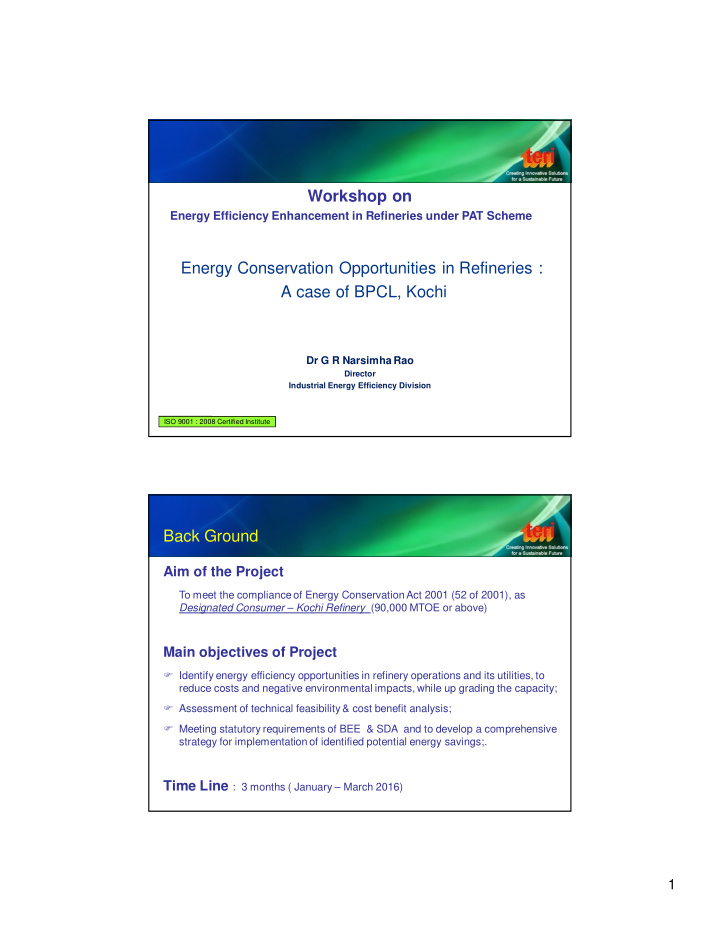



Workshop on Energy Efficiency Enhancement in Refineries under PAT Scheme Energy Conservation Opportunities in Refineries : A case of BPCL, Kochi Dr G R Narsimha Rao Director Industrial Energy Efficiency Division ISO 9001 : 2008 Certified Institute Back Ground Aim of the Project To meet the compliance of Energy Conservation Act 2001 (52 of 2001), as Designated Consumer – Kochi Refinery (90,000 MTOE or above) Main objectives of Project Identify energy efficiency opportunities in refinery operations and its utilities, to reduce costs and negative environmental impacts, while up grading the capacity; Assessment of technical feasibility & cost benefit analysis; Meeting statutory requirements of BEE & SDA and to develop a comprehensive strategy for implementation of identified potential energy savings;. Time Line : 3 months ( January – March 2016) 1
Refinery Profile : BPCL Kochi Installed Capacity : 9.5 MMTPA Integrated Refinery Expansion Project (IREP) under progress to 15.5 MMTPA; To meet the growing demand of petroleum products in Indian market (as well as improve the auto-fuel quality to Euro-IV/VI levels) Energy Audit Methodology • Preliminary Survey • Data Collection Plant records, energy input, equipment specifications, Process flows, etc., • Field Measurements using instruments • Data Analysis (Historic & actual measured data) • Discussions with individual plant production teams • Techno-economic evaluation of energy conservation measures • Presentation to Management • Submission of draft report for Review to Individual units • Discussions with Individual units for acceptance of proposals • Final report submission 2
TERI Experience : Energy Audit Services (Last 3 years) Petroleum & Natural Gas Sector Company Type of Study British Gas India Offshore Exploration Kochi Refinery Lighting Adequacy GAIL Gas Processing Stations HPCL Product Pipeline TERI Experience : Energy Audit Services (Last 3 years) Offshore Exploration Study : Air filter design change for Solar mars turbines; Optimization of wash Cycles; Inter connection of Power systems; Minimizing the flare gas emissions by additional storage (floating). Estimated GHG emission reduction - 9820 MT of CO 2 eq (4% of present level) Lighting Adequacy Study : Implementation investment Rs 225 lakhs Plant Lighting load : 1.75 MW 700 HPSV/HPMV lamps replaced with Metal Halide in Plant premises 17 Induction lamps / LED for street lighting 3 High Mast towers for Improving lighting adequacy levels Optimize the tap setting in lighting transformers Estimated energy conservation Potential - 250 MTOE 3
Refinery Energy Audit How different from other sectors (under PAT) Entry Authorization (permits) for the team Mandatory safety training Daily Work permits for different types of works from different departments Continuous presence of team in field Co-ordination between plant internal team with audit team Refinery Energy Audit How different from other sectors (under PAT) Plant Operating Conditions (EOR, SOR) Plant shutdown due to unforeseen circumstances Understanding process technologies – w.r.t mix of products and technology Documentation (OEM’s design documents) Modifications in process flow from original design Confidentiality 4
Energy Performance : Indian Refineries No of Refineries under PAT : 18 Parameters Unit Range Throughput Million Metric Ton per annum, MMTPA 2.81 - 41.44 NRGF 4.2178 - 10.259 50.9986 (High h ) MBN MMBTU / Barrel / NRGF 99.895 (Low h ) SEC kCal/liter 524 - 1042 Captive energy consumption of refineries is 8.3 liters for barrel of crude (159 liters); Kochi Refinery : PAT Target Based on Refinery submitted data FY 2014-15 Crude Target MBN % MBN Throughput NRGF MBN Reduction Reduction Th.Bbls 78.3944 78496 4.2178 73.1011 5.29 6.75 Based on sectorial target reduction of 5.97% BEE Calculation MBN - Million British Thermal Unit per Thousand barrels per Energy Factor ( MMBTU / Barrel / NRGF ) = (Fuel + Loss) NRGF - Complexity of the refinery Reference : https://beeindia.gov.in/sites/default/files/PAT%20target%20for%20Petroleum%20Refinery.pdf 5
Energy Conservation Opportunities - Process • Optimization of heat sources and using for product pre-heating; • Optimization of valves position as well process parameters and improving yields; • Additional power generation sources (instead of pressure drops); • Optimization of reaction parameters and improve yields; Energy Conservation Opportunities - Utility • Power generation in place of PRDS; • Vapour Absorption System (VAM) in place of vapour compressor system; • Optimum sizing of impellers / pumps and operating practices; • Use of variable speed drives (both HT/LT) for capacity control; • Optimizing boiler capacity utilization and steam consumption; • Reactive power management and use of energy efficient motors 6
Barriers for EC Implementation • Reliability of operations – Running equipment in part load; • OEMs approval for modifications; • Space constraints for implementation; • Continuous operations (Restricted Shut down); • Budget Limitations; Meeting PAT Target Minimizing losses (flaring etc.,); Capacity enhancement of Refinery; Use of external fuels ( Natural gas, etc.,); Crude composition; Technology improvement options; 7
Conclusion Potential exists for improving energy efficiency and energy conservation in refineries with no cost and low cost measures; Review of steam economy on continuous basis; High priority to implement process improvement measures and high investment proposals (with attractive payback period); Use of latest technology in energy monitoring systems. THANK YOU Save Energy. Save our Planet 8
Recommend
More recommend